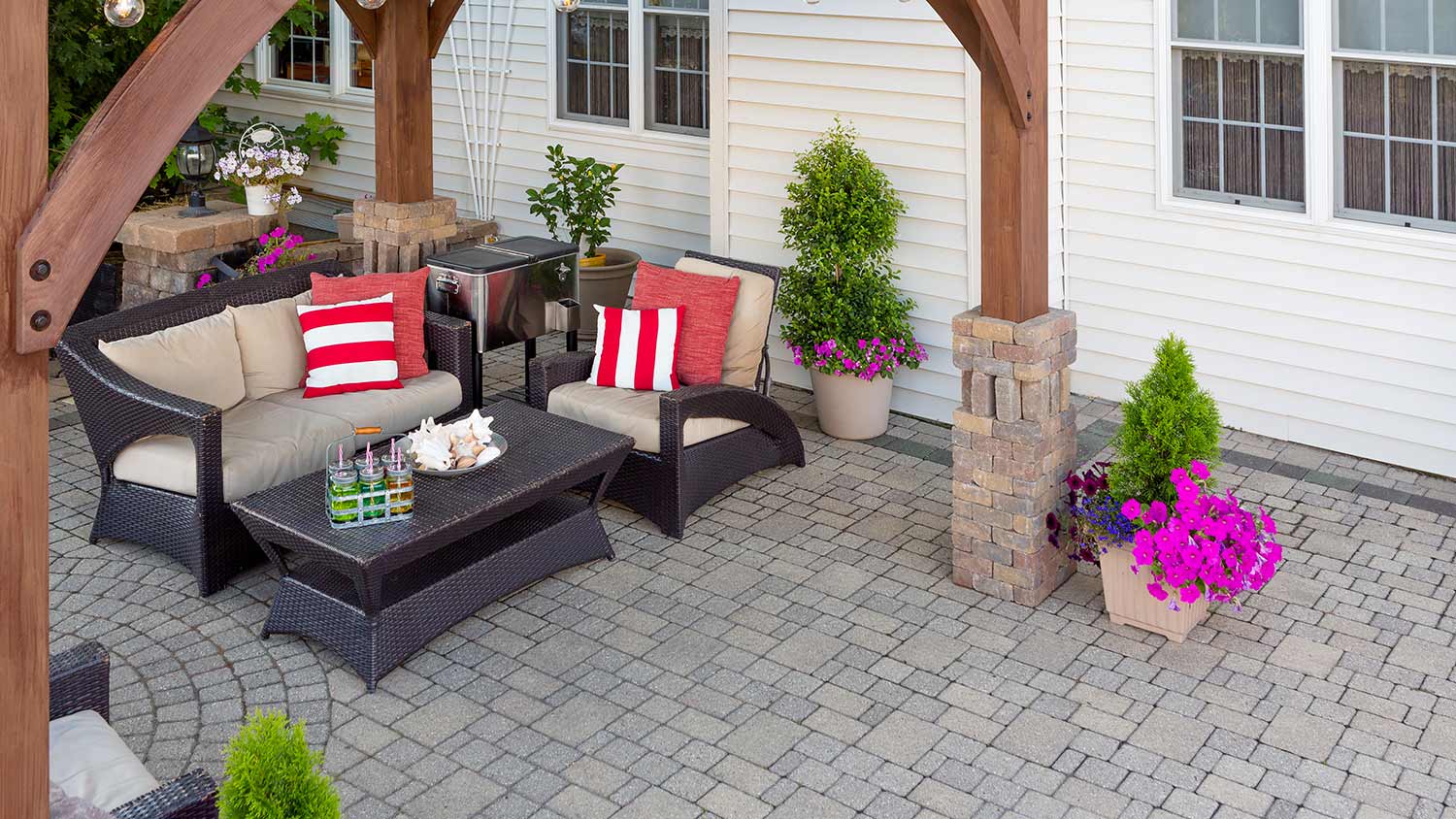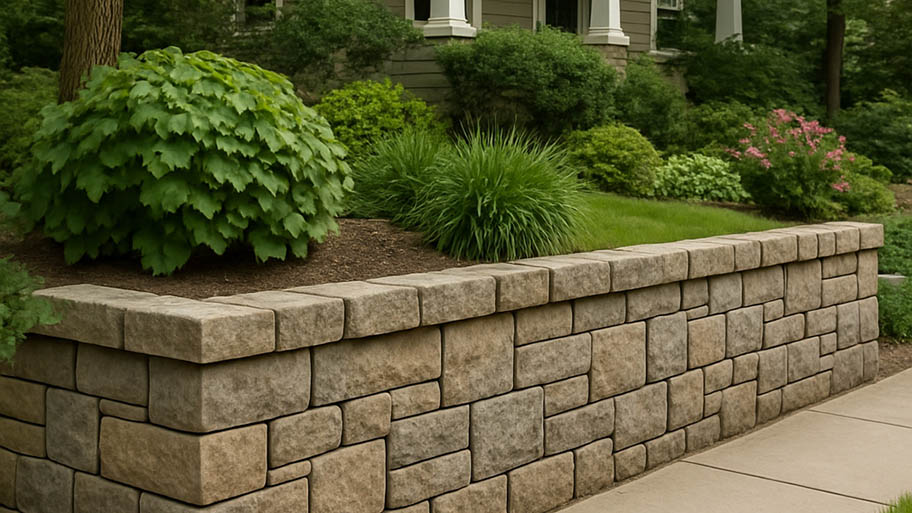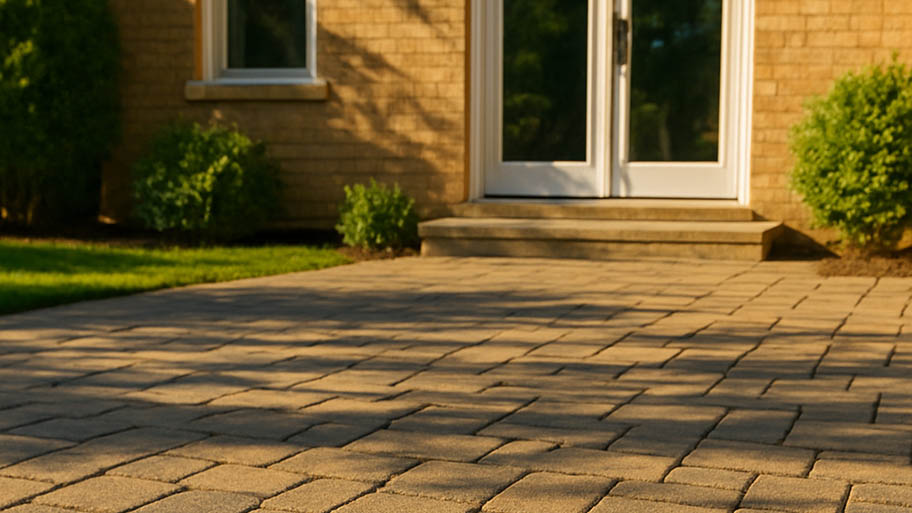
While a stone wall typically costs thousands of dollars, the value it brings to your home can raise its value both aesthetically and monetarily.
Pavers over concrete can be a clever shortcut, but only if conditions are right


It’s possible to lay pavers over concrete, so long as the concrete surface is stable.
The process can save you money and avoid labor-intensive removal.
Always lay a proper sand foundation over the concrete before adding pavers.
If you're tired of cracked and unsightly concrete surfaces near your home, adding paver tiles is a great way to freshen it up. You can install pavers over existing concrete, though it comes with some potential risks, particularly if the concrete surface needs repair. This guide will break down the pros and cons of putting pavers over concrete and see how it compares to investing in a new concrete patio.
| Pros of Adding Pavers Over Concrete | Cons of Adding Pavers Over Concrete |
|---|---|
| Saves money on installation | Lacks long-term stability |
| Increases curb appeal | Potential drainage issues |
| Possible to DIY | Adds to total thickness |
Often, homeowners want to put pavers on top of existing concrete because it's much better than the alternative: tearing up the underlying concrete first. Tearing up concrete can be a messy and potentially expensive job. Fortunately, you can put pavers directly over existing concrete. It's a common practice and a great way to upgrade your concrete surfaces.
The most obvious upside to installing pavers on top of concrete is the cost savings. Concrete removal costs over $1,100 on average and is both labor and time-intensive. You'll pay more for pavers compared to the cost of a new concrete patio, but you will save money on site prep and leveling.
Adding pavers right on top of your concrete is one of the quickest ways to give your patio, driveway, or walkway a makeover. And if you're wondering if you can pour concrete over concrete: yes, this is an option, but not always the most attractive one. Adding a layer of aggregate sand and pavers adds color, texture, and fresh style to your yard.
Learning how to build a paver patio may be a rather advanced DIY, but it is doable with time and the right tools. Handling concrete, on the other hand, is not always ideal, even if you're resurfacing it yourself. Adding pavers over concrete is a job you can tackle over a weekend while saving yourself between $4 and $11 per square foot. All this being said, hiring a paver installation professional near you will ensure it's installed correctly for both drainage and long-term stability.
Sometimes, placing pavers over concrete is risky or not practical. Driveways can be particularly tricky, and if a surface is in very bad shape, it's wise to get rid of the existing concrete first.
There are several problems with pavers over concrete when it comes to longevity and safety. If there were previous issues with uneven concrete, cracks, or spalling, your pavers could begin to sink over time. You will need to add a layer of sand below the pavers to offer them flexibility in the winter, but this will not offer as much stability as fresh soil. You could also hire a local concrete leveler to ensure a sturdy foundation before installing the pavers.
Always check local laws about ensuring drainage in and around any hardscape installations on your property. Adding pavers over concrete—even with the extra layer of sand—can significantly hinder stormwater from seeping through the stone or bricks. If the water has nowhere to go, it can pool around your home or lead to erosion on your lawn.
Any time water pools and collects you risk drowning your plants or, even worse, fungus growth. Fungus loves to grow in wet areas. If it doesn’t dry it can kill your plants, grass, and the surrounding yard.
Increasing the thickness of your patio by adding pavers can make your patio, driveway, or walkway impractical. Not only will it cause drainage issues, but it also could block your door clearance for leaving and entering the yard.
So, how thick should a patio be? A patio should sit between 4 and 8 inches, depending on how much weight it holds. If the pavers push the thickness too far, you may need to figure out how to cut concrete pavers to fit your needs.
Comparing pavers versus concrete is a common decision to make when designing your dream outdoor space. Pavers come in a series of shapes, colors, and materials, but all in all, they are a series of manufactured stones or bricks that link together. Concrete, on the other hand, is either poured or delivered as a solid slab of aggregate and cement.
Pavers cost more to install than concrete but typically last longer and are easier—and less expensive—to repair. Pavers are also better for encouraging drainage due to their interlocking arrangement, especially if you opt for a permeable paver system. However, concrete comes in pervious options as well and can encourage drainage when installed at the proper angle.
There are ways to customize both pavers and concrete. You can even add a stamped concrete overlay that gives the look of pavers at a lower price. The cost of a new concrete slab, after all, ranges from around $4 to $8 per square foot, whereas the cost of pavers can cost up to $50 per square foot. However, the stamped concrete versus pavers debate is more complex, so you should always speak with your contractor to decide.

If you’re looking to do the job yourself, there are a few tips you should keep in mind as you lay pavers over concrete:
Inspect the area first to ensure it’s sloped enough for water runoff. Otherwise, the ground can’t absorb the water, creating drainage issues.
Work with a clean, dry surface—use a pressure washer to blast all that grime off.
You can use sand over the existing concrete to create a foundation for the pavers.
To keep the edges of the pavers in place, secure the perimeter with mortar or another type of adhesive.
If you have a good foundation of undamaged concrete, installing pavers on top can be a doable DIY project. It’ll definitely take some patience and care to ensure your pavers are secure and line up correctly, but if you have previous experience, you may want to give it a try.
You’ll save around $50 to $80 per hour or $4 to $11 per square foot on labor. However, you will still have to pay for the pavers and spacers, as well as installation tools and materials like a circular saw, leveling sand, and landscaping cloth.
If you’re at all intimidated by the installation process, your concrete is badly damaged, or you don’t have many relevant tools handy, it may be better to leave this job to the pros.
If the concrete isn’t in good shape, installing pavers over it could result in an uneven surface or instability. Here are some signs that you need to remove or replace the concrete first:
Major Cracks or Crumbling: If your concrete shows severe cracking and appears to be falling apart, it can lead to shifting or uneven pavers over time.
Concrete Isn’t Level: It’s much easier to remove old concrete and start fresh with a flat base than to end up with uneven paver installation after the fact.
Pooling Water: If water tends to collect in certain areas of your concrete, it’s a sign of poor drainage. Installing pavers over it will only make the issue worse.
Large Sunken Areas: These indicate structural issues with the concrete, and it’s best to replace it rather than covering it up.
Taking the time to address these underlying issues now will save you a lot of headaches (and repairs) later on. Look for a concrete removal service near you to help you replace the old concrete.
From average costs to expert advice, get all the answers you need to get your job done.

While a stone wall typically costs thousands of dollars, the value it brings to your home can raise its value both aesthetically and monetarily.

Pea gravel is a good-looking, versatile landscaping stone that's a favorite of the pros. Read about how much pea gravel costs for both installation and the stone itself.

Kick erosion to the curb with an eye-catching retaining wall. Retaining wall costs vary based on the material, but this guide will help you budget.

Discover travertine pavers costs to learn about installation, materials, and labor prices, plus tips to save on your travertine paver project.

Comparing concrete pavers versus brick pavers for your next project? See how the cost, appearance, maintenance, ROI, and more can impact your decision.

Pavers can turn an ordinary driveway, walkway, or patio into a thing of art—but how do you protect your investment? Find out if pavers need to be sealed and learn pros and cons.